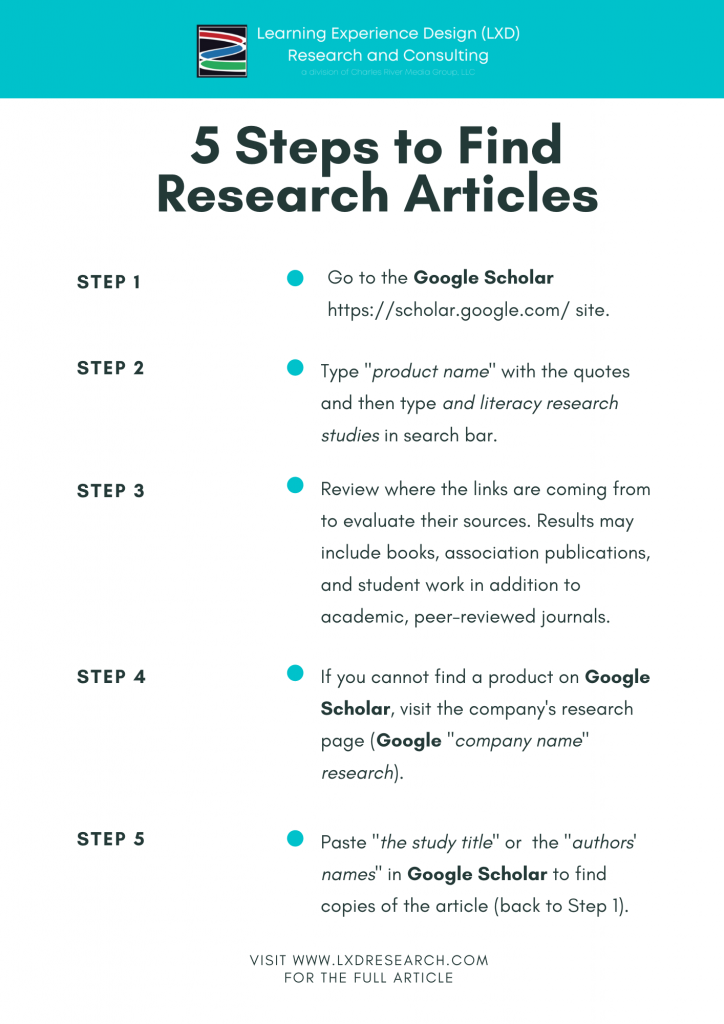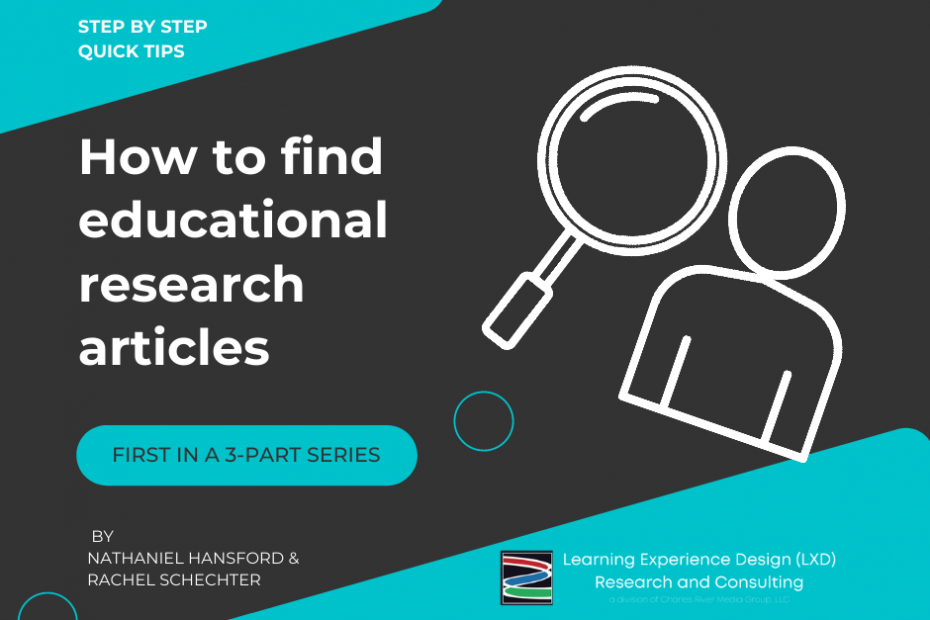Co-written by Nathaniel Hansford, teacher and author of The Scientific Principles of Teaching and Pedogogynongrata.com and Rachel Schechter, PhD, head of LXD Research and former research leader at HMH and Lexia Learning, where she led the publication of 11 peer-reviewed, academic journal articles and over a dozen peer-reviewed, research presentations with organizations such as the International Dyslexia Association, International Literacy Association, the International Society for Technology in Education, and the American Evaluation Association.
As educators, you are constantly inundated with strategies, pedagogies, and programs that claim to be evidence-based. This is exciting, but what is the evidence, and where can you read about these findings? K-12 students are taught to question, use multiple sources, and weigh the reliability of the narrator, and now it’s your turn. How do you critically evaluate the evidence-based claims about educational products that you may want to incorporate into your teaching? While persuasive summaries or highlights on a product website may provide an air of gravitas, going straight to the source and reading the original article usually results in the most objective understanding of the research findings. Recognizing that this “original source” strategy takes time and training, we’re going to help. We can’t give you more blocks or periods in your already stretched-to-the-max teaching day (we wish we could!), but we can give you information and strategies for efficient and focused review.
We are rolling out a three-part article series to provide you with the training you need to find and interpret education research. Our goal is to empower you as an educator to be a more knowledgeable and prepared consumer in order to better advocate for yourself and your students.
How to Assess Research Quality
First, let’s talk about the quality of research. Believe it or not, anyone can do a study and call it research. Companies can conduct their own research or pay others to do research for them. When looking online, the main places research may be published are on a company’s own website, in an academic journal, or through a third-party organization. When looking at research, consider who paid for the research – was it the company, was it industry-sponsored, government-sponsored, or NGO-funded? Usually, research funded by a specific company is going to have more positive results. Studies with negative or neutral results are often not published. Ideally, we want to seek out independently funded and/or peer-reviewed sources that are published in an academic journal or conference proceedings. Peer review means that the author of the research has had other experts within the field check their work for accuracy, which is usually the case with academic journals. However, research that is independently funded or published in a peer-reviewed source may not exist. This does not mean that we should throw out every study result that does not meet these criteria but that we should treat company-funded and non-peer-reviewed research with greater skepticism.
How to Find A Research Article
Most academic journals require a subscription; however, there are also plenty of “open access” sources of research articles that are free. Here are three main ways to find a free copy of a research study:
- Google Scholar may be the most accessible journal database that includes free articles: https://scholar.google.com/. Sometimes, the first result may not link to a free version, so click on “see all 16 versions” to check if it may be there. If you still can’t get a free copy from the search results…
It may be on the Online College.org list of 99 free academic journals. No luck? Then maybe check…
- Your local library network (or a university library if you have a connection). Our favorites are ERIC, Education Source, and Sage.
- ResearchGate may have full-text copies of studies that you can look up by author or title.
How to Best Use Search Engines
Let’s say we want to answer the question: What does the research say about Daily 5?
Quick Tip: Even if you have access to paid journals like Education Source or Sage, it is sometimes easier to find relevant articles on Google Scholar first and then search by title and author on the paid sites, because Google is a better-designed search engine.
How to Best Use Search Engines
Let’s say we want to answer the question: What does the research say about Daily 5?
Step 1: Go to Google Scholar (https://scholar.google.com/).
Step 2: Type “Daily 5” and literacy research studies. It is important to use quotation marks and the conjunction and in between the terms. If we just type a phrase into the search engine without quotation marks, it will give any article with those keywords, not just the ones that use that exact phrase. So, for example, if we searched the effectiveness of Daily 5, we would get all articles that use the words daily, 5, and effectiveness in their description. Including the term literacy dramatically improves the relevance of the results! (Without it, only two out of the top results are education articles.)
Step 3: Review the links to see where the results are coming from. Some may be peer-reviewed journal articles, but others may be books, association journals (e.g., The Reading Teacher is published by the International Literacy Association), newsletters, or dissertations (Proquest is a popular host of student work).
Step 4: If you cannot find an article through Google Scholar, switch to regular Google and search for “company name” research to find their research page.
Step 5: Use the study title and authors back on Google Scholar to find the original article.

Quick tip: Review the whole list of research on a company’s website. Note that the most positive stories may be at the top.
What should I know about company-sponsored research?
Most education companies have a research section on their website that lists many relevant studies on a single page. If published in a journal, the studies are often free to access, or there are summaries of the studies available to download (you may need to give an email address in exchange). For example, if we go to the CKLA website, it has a whole section titled “Research Studies” that lists almost every study on the program. Just remember that when you look at the research that companies are highlighting, it is important to check who wrote the paper. If you’re struggling to find the research section on a company’s website, it can sometimes be easier to go to Google and just search the topic and the word research or studies. For example, if you Google “CKLA” and research, the first result that comes up is CKLA’s research page. If you want to find a lot of research on a specific topic, you can also search the name of the topic plus a literature review or meta-analysis. This will identify articles that seek to review all the literature on an entire topic. You can then look through the article’s bibliography to find a list of relevant articles, which you can then search for on Google Scholar. Even if you do not have a subscription to the journal in which the article is published, a journal website will still show you the abstract, the authors’ names, and the bibliography.
Quick tip: Researchers’ bibliography pages are also great resources when you find an author with a helpful article:Jayanthi Mistry at Tufts University.
This is great, but are there trustworthy research summaries already out there?
If you are still unsure about searching for original study articles, there are some websites that highlight and translate research for educators. Such websites include Reading Rockets, Science of Reading Info, and Visible Learning Metax, as well as author websites (e.g., Shanahan on Literacy). These websites, while not peer-reviewed themselves, seek to review peer-reviewed research and present it in easy-to-read language. Education-focused news sources such as The 74 Million, Edsurge, and the NY Times also often share information about research studies (although the ones that make the news often buck popular opinion or make waves). Don’t forget that there are also a number of sites that review and summarize research, such as What Works Clearinghouse and Evidence for ESSA (check out this article for details on these and others like them). That being said, it is important to understand that all websites and articles have their own criteria for review.
You can do this!
As you hone your ability to find and understand evidence-based research, you are skill-building in a way that will elevate your curricular choices and also enable you to model active and intentional inquiry for your students. Maybe tell them the story of the research behind the products they’re using and how you found the research and evaluated the findings. Help your K-12 students develop their research evaluation skills right along with you!
Keep an eye out for the next article in this series that answers the question: Now that I found the research article, how do I read this thing?

